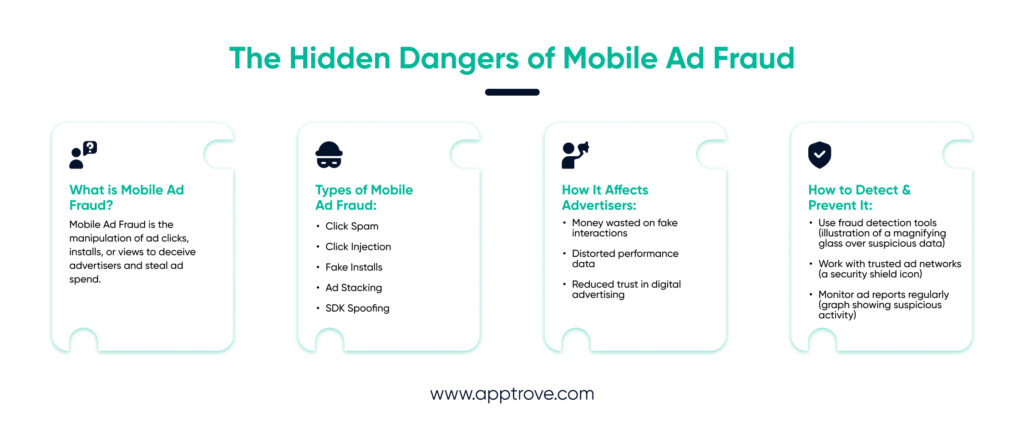What is Mobile Ad fraud?
Mobile Ad Fraud occurs when scammers deceive advertisers by forging clicks, downloads, or views on ads displayed on mobile devices such as smartphones or tablets. It is kind of like if you suggest that you finished your homework, but in reality, you have just stolen somebody’s solutions. Advertisers suffer financial loss because they pay for advertisements that are not even seen or clicked on by real users.

Types of Mobile Ad Fraud
Click Spam:
Click spam is the kind of Mobile Ad Fraud where swindlers persuade the advertisers to see the ad as the one that has been clicked many times in reality no user interacted with it. It is akin to forcibly pressing a friend’s social media likes without their permission, thus coming up with fake popularity.
Click Injection:
The Mobile Ad Fraud of Click Injection is when scammers secretly add fake clicks at the last moment before someone installs an app. This makes advertisers pay the scammer for a download they did not earn. To illustrate, it is like someone who joins a group project at the end and puts his name to the work he has never done.
Fake Installs:
Fake installs take place when dishonest individuals employ bots or users to craft false app downloads many times. Advertisers are left footing the bill for app installations that aren’t real users. This is similar to creating multiple fake accounts on social media to boost your follower count artificially.
Ad Stacking:
Ad stacking is when several ads are placed on top of each other in a single spot. Users only see the top ad, but advertisers are charged for all the ads stacked underneath, whether they are visible or not. It’s like paying for an entire pile of magazines and only being able to read the one on top.
SDK Spoofing:
SDK spoofing is a form of mobile ad fraud that is based on scammers imitating the signals sent by apps to ad networks. They act as though a user has clicked an ad, downloaded it, or used an app when in reality none of these things happened. It’s like hacking the system at your school so that the attendance sheet shows you were present, although the truth is that you were absent.

Why does Mobile Ad Fraud happen?
Mobile Ad Frauds are taking advantage of the fact that the advertisers’ system is structured in such a way that they can effortlessly make money even if they are fraudsters. Truthful clicks or app downloads are the exact statistics that should be watched by advertisers to let them know if they are on the right track. Evildoers, on the other hand, do not benefit from the cooperation of fraudsters; they curdle the advertising budget by taking advantage of the available trust, therefore the money goes to the wrong advertiser, and the wrong audience is influenced.
How to Detect Mobile Ad Fraud?
Detecting Mobile Ad Fraud involves meticulously studying parameters, the following, for example:
- Abnormal click rates: Swiftly appearing or vanishing clicks that are not a part of the regular customer activity.
- Rapid installs: You can see instant or unrealistic numbers of times in a day belonging to a single source download.
- Suspicious user locations: Such samples as the installs or clicks from not matching the audience’s unusual locations or devices on the points not corresponding to the target, which can be called “good traffic,” will be suspicious.
Protecting Against Ad Frauds
Advertisers can protect themselves from these frauds by:
- Using fraud detection tools to monitor ad traffic closely.
- Working only with trusted ad networks and partners.
- Regularly reviewing ad performance reports for irregularities.
- Implementing strict rules about who can access advertising campaigns.
Conclusion
Mobile Ad Fraud has the potential to do a lot of harm. Practically speaking, it is a theft dressed up as a marketing service, and the clown confetti falls on the traders, not the business. This is done at traditional banks by verifying the serial numbers and then the rate changes can be computed. Hence the banks and not the clients are under scrutiny.
The comprehension of this problem leads to such a conclusion that it is very utility if one is least insecure about thinking about solutions. Historically, great technologies were created to serve people partially using their minds to help it get done; today a computer must do all.